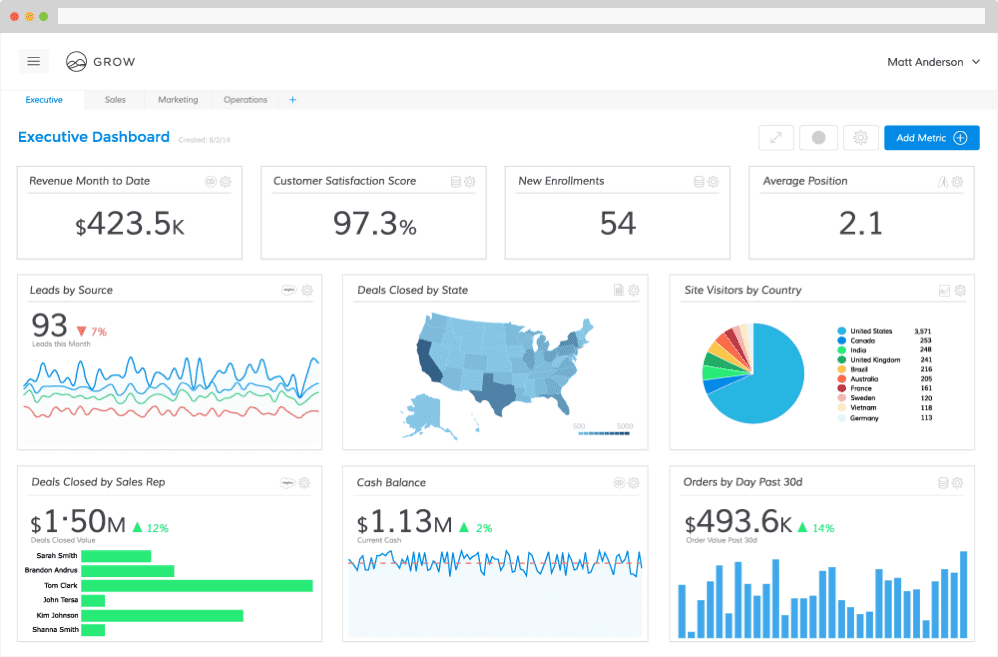What does business intelligence software cost?
Short answer: enough that it’s a serious investment.
Many business intelligence software companies don’t list their product’s cost on their website; they tell you to give them a call. There’s a legitimate reason for this, given how many different needs BI software can meet and how customizable it can be to each business.
However, it’s still frustrating.
You’re ready to cross that BI bridge to data-driven business decisions, but you instead have to call a company and answer further questions.
The Average Cost of a Business Intelligence Software License
So what’s the average cost of business intelligence software?
About $3,000 per year.
Mind you, my $3,000 figure is taken from a sample of eleven companies, and it doesn’t account for all of the versions a BI vendor may offer. In coming to my average, I went with the most basic, least expensive plan for each vendor. Plans differed by the number of users.
You don’t need this much, but the software isn’t cheap.
Within that $3,000 average, the prices range from $600 per year on the lower end, to $6,000 per year at the top. Two are on the lower end ($504, $600), five are in the middle ($1068, two at $1,200, $2,000, and $2,800), and four are high ($5,195, $5880, and two at $6,000).
It’s worth noting that tech research giant Gartner’s take on buying BI software is that “cost should be a secondary consideration to the achievement of business benefits” (full content available to Gartner clients).
BI software isn’t cheap, but the potential benefits are so great that they should be your priority.
It’s also worth noting that the businesses that focus most on cost seem to benefit the least. A recent Gartner survey finds that buyers who focused primarily on cost “reported the lowest average overall business benefit” (full content available to Gartner clients).
Businesses that focused primarily on program functionality (what and how much their BI program can do) reported the highest business benefit.
Think of BI software as a Fitbit, or any fitness tracker, for your business. That initial price seems steep, but if you truly incorporate the data-driven insights into the fitness of your body —or your business— it pays off.

Both Fitbit and BI software orient your life around data. That can pay off.
There are options out there that cost way more than my $3,000 average. Those are targeted at enterprise-sized businesses, however. There are also free business intelligence tools out there, if you’re an SMB without a large IT budget, though they tend to be comparatively limited (they only extend to one, occasionally two, users).
Ask Vendors the Right Questions to Find the Right BI Software
You’ll want to ask your vendor what the price is per user. Most firms charge by the user, but there are differences within that.
For instance: BI firm Bime’s base plan is $600 a month (billed monthly) for two users (or $490/month billed annually, coming out to $5,880), and $90/month for each extra user. Viewers, who can see visualizations, but can’t use the software, are another option. Bime offers ten viewer licenses for another $90/month.

A BIME infographic listing various Star Wars vehicles. If you knew that without the caption, please email me.
You’ll also want to ask about their pricing model in general. Not all BI companies do payment and pricing by the number of users.
Grow, for example, charges by the number of metrics you use (i.e., how many things you want to track), rather than by number of users. If you’re a small business only interested in, say, customer demographics by age or geography, then something like Grow could be a good option. It also offers unlimited customer service, which is frequently praised in Grow’s user reviews.

A visualization from Grow
It might seem obvious, but you need to consider why you want business intelligence software in the first place. The majority of BI implementations fail. If you know specifically what you want to achieve, you’ve got a better chance at avoiding failure.
Take BI expert Rick Sherman’s advice in his "Business Intelligence Guidebook," and avoid using hazy goals such as “get a single version of the truth” or achieve “better decision-making.” Sherman suggests, instead, that BI shoppers focus on specifics like “revenue optimization, cost reductions, risk reductions,” and “regulatory compliance.”
In other words? Align your BI software goals with business initiatives rather than buzzwords.
Be conscientious when determining those requirements. Gartner suggests designing a BI selection team before you start shopping (full content available to Gartner clients). Even if you lack the time, or employees, to devote to a selection committee, you’ll still want to define the target users and usage scenarios.
Cloud Business Intelligence Software Reduces Costs
One way you can decrease the cost of business intelligence software is by opting for a cloud option.
When you buy an on-premises solution, you’ll probably have to invest in the necessary hardware (servers upon servers), as well as the IT staff to maintain it.
With cloud software, the servers where your information is stored are elsewhere—either on the software vendor’s servers, or at Google Cloud Platform or Amazon Web Services or whichever cloud provider the BI provider uses.When you’re browsing Capterra’s business intelligence software directory, use the “Deployment” filter, and click on “web-based” to see only cloud BI software options.
Your BI Buying Experience
Have you bought business intelligence software? I’d love to hear about your experience, and what else you learned. Was your product priced differently than what I found?
Let me know in the comments below!